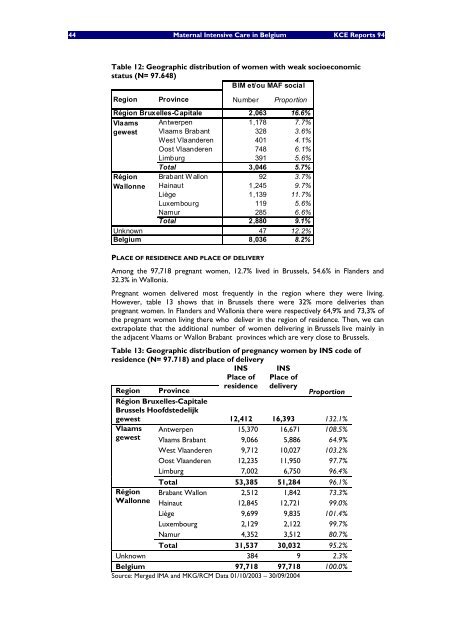Soins maternels intensifs (Maternal Intensive Care) en Belgique - KCE
Soins maternels intensifs (Maternal Intensive Care) en Belgique - KCE
Soins maternels intensifs (Maternal Intensive Care) en Belgique - KCE
You also want an ePaper? Increase the reach of your titles
YUMPU automatically turns print PDFs into web optimized ePapers that Google loves.
44 <strong>Maternal</strong> <strong>Int<strong>en</strong>sive</strong> <strong>Care</strong> in Belgium <strong>KCE</strong> Reports 94<br />
Table 12: Geographic distribution of wom<strong>en</strong> with weak socioeconomic<br />
status (N= 97.648)<br />
BIM et/ou MAF social<br />
Region Province Number Proportion<br />
Région Bruxelles-Capitale<br />
2,063 16.6%<br />
Vlaams Antwerp<strong>en</strong> 1,178 7.7%<br />
gewest Vlaams Brabant 328 3.6%<br />
West Vlaander<strong>en</strong> 401 4.1%<br />
Oost Vlaander<strong>en</strong> 748 6.1%<br />
Limburg 391 5.6%<br />
Total 3,046 5.7%<br />
Région Brabant W allon 92 3.7%<br />
Wallonne Hainaut 1,245 9.7%<br />
Liège 1,139 11.7%<br />
Luxembourg 119 5.6%<br />
Namur 285 6.6%<br />
Total 2,880 9.1%<br />
Unknown 47 12.2%<br />
Belgium 8,036 8.2%<br />
PLACE OF RESIDENCE AND PLACE OF DELIVERY<br />
Among the 97,718 pregnant wom<strong>en</strong>, 12.7% lived in Brussels, 54.6% in Flanders and<br />
32.3% in Wallonia.<br />
Pregnant wom<strong>en</strong> delivered most frequ<strong>en</strong>tly in the region where they were living.<br />
However, table 13 shows that in Brussels there were 32% more deliveries than<br />
pregnant wom<strong>en</strong>. In Flanders and Wallonia there were respectively 64,9% and 73,3% of<br />
the pregnant wom<strong>en</strong> living there who deliver in the region of resid<strong>en</strong>ce. Th<strong>en</strong>, we can<br />
extrapolate that the additional number of wom<strong>en</strong> delivering in Brussels live mainly in<br />
the adjac<strong>en</strong>t Vlaams or Wallon Brabant provinces which are very close to Brussels.<br />
Table 13: Geographic distribution of pregnancy wom<strong>en</strong> by INS code of<br />
resid<strong>en</strong>ce (N= 97.718) and place of delivery<br />
INS INS<br />
Place of Place of<br />
Region Province<br />
resid<strong>en</strong>ce delivery<br />
Proportion<br />
Région Bruxelles-Capitale<br />
Brussels Hoofdstedelijk<br />
gewest 12,412 16,393 132.1%<br />
Vlaams Antwerp<strong>en</strong> 15,370 16,671 108.5%<br />
gewest Vlaams Brabant 9,066 5,886 64.9%<br />
West Vlaander<strong>en</strong> 9,712 10,027 103.2%<br />
Oost Vlaander<strong>en</strong> 12,235 11,950 97.7%<br />
Limburg 7,002 6,750 96.4%<br />
Total 53,385 51,284 96.1%<br />
Région Brabant Wallon 2,512 1,842 73.3%<br />
Wallonne Hainaut 12,845 12,721 99.0%<br />
Liège 9,699 9,835 101.4%<br />
Luxembourg 2,129 2,122 99.7%<br />
Namur 4,352 3,512 80.7%<br />
Total 31,537 30,032 95.2%<br />
Unknown 384 9 2.3%<br />
Belgium 97,718 97,718 100.0%<br />
Source: Merged IMA and MKG/RCM Data 01/10/2003 – 30/09/2004

















